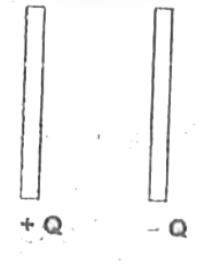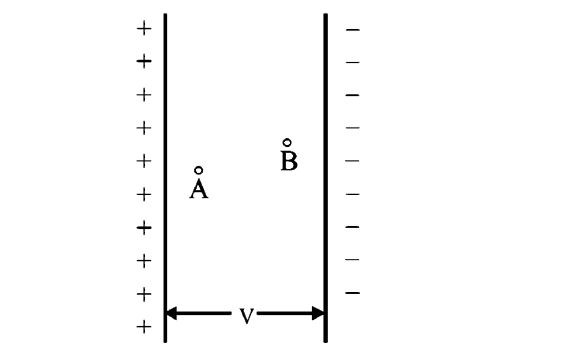Plates of a parallel plate capacitor, having a potential difference 100 V applied across them, carry a surface charge density of 50 nC cm−2. Spacing between the plates is
329μm
259μm
177μm
125μm
The correct Answer is:C
To find the spacing between the plates of a parallel plate capacitor given the potential difference and surface charge density, we can follow these steps:
Step 1: Understand the given values
- Potential difference (V) = 100 V
- Surface charge density (σ) = 50 nC/cm²
Step 2: Convert surface charge density to SI units
Surface charge density in SI units is expressed in coulombs per square meter (C/m²).
1 nC = 10−9 C, and 1 cm2=10−4 m2.
Thus,
σ=50nC/cm2=50×10−9C/(10−4m2)=50×10−5C/m2=5.0×10−5C/m2
Step 3: Use the relationship between charge, capacitance, and potential difference
The capacitance (C) of a parallel plate capacitor is given by:
C=ε0Ad
where:
- ε0 = permittivity of free space =8.85×10−12C2/N m2
- A = area of the plates
- d = distance between the plates
The charge (Q) on the plates can also be expressed as:
Q=σA
Step 4: Relate charge to capacitance and potential difference
Using the relationship Q=C⋅V:
σA=ε0Ad⋅V
Step 5: Cancel A and rearrange to find d
By canceling A from both sides, we have:
σ=ε0Vd
Rearranging gives:
d=ε0Vσ
Step 6: Substitute the known values
Substituting the known values into the equation:
d=(8.85×10−12C2/N m2)⋅(100V)5.0×10−5C/m2
Step 7: Calculate d
Calculating the above expression:
d = \frac{8.85 \times 10^{-10}}{5.0 \times 10^{-5}} = 1.77 \times 10^{-5} \, \text{m} = 177 \, \text{µm} = 177 \, \text{nm}
Final Answer
The spacing between the plates is 177nm.
---
- Potential difference (V) = 100 V
- Surface charge density (σ) = 50 nC/cm²
Surface charge density in SI units is expressed in coulombs per square meter (C/m²).
Thus,
σ=50nC/cm2=50×10−9C/(10−4m2)=50×10−5C/m2=5.0×10−5C/m2
The capacitance (C) of a parallel plate capacitor is given by:
C=ε0Ad
where:
- ε0 = permittivity of free space =8.85×10−12C2/N m2
- A = area of the plates
- d = distance between the plates
Q=σA
Using the relationship Q=C⋅V:
σA=ε0Ad⋅V
By canceling A from both sides, we have:
σ=ε0Vd
Rearranging gives:
d=ε0Vσ
Substituting the known values into the equation:
d=(8.85×10−12C2/N m2)⋅(100V)5.0×10−5C/m2
Calculating the above expression:
d = \frac{8.85 \times 10^{-10}}{5.0 \times 10^{-5}} = 1.77 \times 10^{-5} \, \text{m} = 177 \, \text{µm} = 177 \, \text{nm}
The spacing between the plates is 177nm.
Similar Questions
Consider a parallel plate capacitor having charge Q. Then,

View SolutionThe plates of a parallel plate capacitor are charged to a potential difference of 117 V and then connected across a resistor. The potential difference across the capacitor decreases exponentially with to time.After 1s the potential difference between the plates is 39 V, then after 2s from the start, the potential difference (in V) between the plates is
View Solution
Knowledge Check
A parallel plate air capacitor is charged to a potential difference of V volts. After disconnecting the charging battery the distance between the plates of the capacitor is increased using an isulating handle. As a result the potential difference between the plates
AincreasesBdecreaseCdoes not chargeDbecomes zero
The plates of a parallel-plate capacitor in vacuum are 5.00mm apart and 2.00m2 in area. A potential difference of 10,000V is applied across the capacitor. Compute
(a) the capacitance
(b) the charge on each plate, and
(c) the magnitude of the electric field in the space between them.
View SolutionTwo protons A and B are placed in between the two plates of a parallel plate capacitor charged to a potential difference V as shown in the figure. The forces on the two protons are identical.

View SolutionIn a parallel plate capacitor, the distance between the plates is d and potential difference across the plate is V. Energy stored per unit volume between the plates of capacitor is
View SolutionA parallel plate capacitor is charged. If the plates are pulled apart
View SolutionA parallel plate air capacitor is charged to a potential difference of V volts. After disconnecting the charging battery the distance between the plates of the capacitor is increased using an isulating handle. As a result the potential difference between the plates
View SolutionA parallel plate air capacitor is charged to a potential difference of V volts. After disconnecting the charging battery the distance between the plates of the capacitor is increased using an isulating handle. As a result the potential difference between the plates
View SolutionA 5.80μF parallel-plate air capacitor has a plate separation of 5.00mm and is charged to a potential difference of 400V. Calculate the energy density in the region between the plates, in Jm3
View Solution
